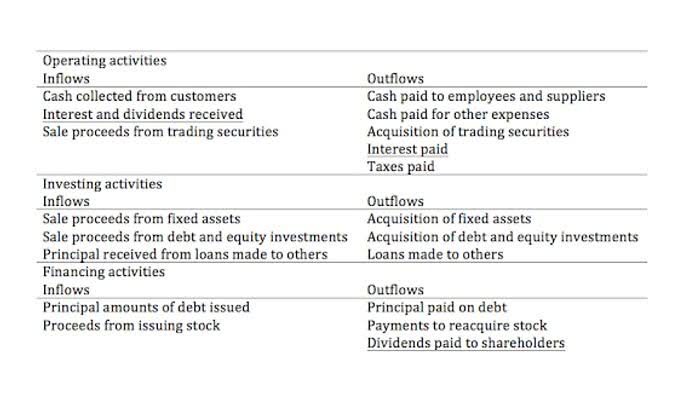The Current Ratio is a measure of a company’s near-term liquidity position, or more specifically, the short-term obligations coming due within one year. What makes the current ratio “good” or “bad” often depends on how it is changing. A company that seems to have an acceptable current ratio could be trending towards a situation where it will struggle to pay its bills. Conversely, a company that may appear to be struggling now, could be making good progress towards a healthier current ratio. In the first case, the trend of the current ratio over time would be expected to have a negative impact on the company’s value.
Related Skills for Accounting Careers
This would indicate that the company can cover its liabilities with its assets. If the current ratio is lower than one, it could mean that the company has too many liabilities to cover with assets alone and it might have to take out additional loans. Assume company ABC has $1.5 billion in assets and $1 billion in liabilities (debt). Other ratios often used to complement current ratio analysis include receivables turnover ratio inventory turnover ratio and cash conversion cycle.
How to Pay Off Your Business Debt, Fast
A ratio greater than 1 means that the company has sufficient current assets to pay off short-term liabilities. Companies with shorter operating cycles, such as retail stores, can survive with a lower current ratio than, say for example, a ship-building company. The current ratio should be compared with standards — which are often based on past performance, industry leaders, and industry average. Current assets refer to cash and other resources that can be converted into cash in the short-term (within 1 year or the company’s normal operating cycle, whichever is longer).
What is your risk tolerance?
To calculate the ratio, analysts compare a company’s current assets to its current liabilities. The current ratio is calculated by dividing the value of a company’s tangible assets by the value of its liabilities. Tangible assets can be converted into a monetary value – including vehicles, buildings and machinery – while liabilities include longer-term debt, such as salaries and taxes. A current ratio of 1 is safe because it means that current assets are more than current liabilities and the company should not face any liquidity problem. A current ratio below 1 means that current liabilities are more than current assets, which may indicate liquidity problems.
How the Current Ratio Changes Over Time
For example, a retail business may have a higher level of inventory during the holiday season, which could impact its ratio of assets to liabilities. Further, a company may need to borrow more during slow seasons to fund its operations, which could also impact the current ratio. For example, a company’s inventory, which can prove difficult to liquidate, could account for a substantial fraction of its assets.
If a company has a current ratio of 100% or above, this means that it has positive working capital. Hence, Company Y’s ability to meet its current obligations can in no way be considered worse than X’s. The offers that appear on this site are from companies that compensate us. But this compensation does not influence the information we publish, or the reviews that you see on this site. We do not include the universe of companies or financial offers that may be available to you. Being familiar with this consideration is crucial when it comes to interpreting current ratio values in finance.
Calculating the current ratio at just one point in time could indicate that the company can’t cover all of its current debts, but it doesn’t necessarily mean that it won’t be able to when the payments are due. It can have a significant impact on how traders and investors see a company, which means the ratio can influence the share price. A high current ratio could have a positive effect on share prices, while a low current ratio could cause stock prices to drop. FedEx has more current assets than current liabilities, and its current ratio is over 1.0. What is considered to be a good current ratio depends highly on the business type and industry.
The current ratio or working capital ratio is a ratio of current assets to current liabilities within a business. However, special circumstances can affect the meaningfulness of the current ratio. For example, a financially healthy company could have an expensive one-time project that requires outlays of cash, say for emergency building improvements.
Because buildings aren’t considered current assets, and the project ate through cash reserves, the current ratio could fall below 1.00 until more cash is earned. Current liabilities include accounts payable, wages, accrued expenses, accrued interest and short-term debt. The current ratio accounts for all of a company’s assets, whereas the quick ratio only counts a company’s most liquid assets.
It’s ideal to use several metrics, such as the quick and current ratios, profit margins, and historical trends, to get a clear picture of a company’s status. On the other hand, a current ratio greater than one can also be a sign that the company has too much unsold inventory or cash on hand. Another practical measure of a company’s liquidity is the quick ratio, otherwise known as the “acid-test” ratio. Here, the company could withstand a liquidity shortfall if providers of debt financing see the core operations are intact and still capable of generating consistent cash flows at high margins. The range used to gauge the financial health of a company using the current ratio metric varies on the specific industry.
A financial professional will offer guidance based on the information provided and offer a no-obligation call to better understand your situation. Someone on our team will connect you with a financial professional in our network holding the correct designation and expertise. Our writing and editorial staff are a team of experts holding advanced financial designations and have written for most major financial media publications. Our work has been directly cited by organizations including Entrepreneur, Business Insider, Investopedia, Forbes, CNBC, and many others. Finance Strategists has an advertising relationship with some of the companies included on this website.
It is important to note that a similar ratio, the quick ratio, also compares a company’s liquid assets to current liabilities. However, the quick ratio excludes prepaid expenses and inventory from the assets category because these can’t be liquified as easily as cash or stocks. The current ratio (also known as the current asset ratio, the current liquidity ratio, or the working capital ratio) is a financial analysis tool used to determine the short-term liquidity of a business. It takes all of your company’s current assets, compares them to your short-term liabilities, and tells you whether you have enough of the former to pay for the latter. The current ratio, also known as the working capital ratio, measures the capability of a business to meet its short-term obligations that are due within a year.
The current ratio is one of many liquidity ratios that you can use to measure a company’s ability to meet its short-term debt obligations as they come due. The current ratio compares a company’s current assets to its current liabilities. Both of these are easily found on the https://www.bookkeeping-reviews.com/ company’s balance sheet, and it makes the current ratio one of the simplest liquidity ratios to calculate. A more conservative measure of liquidity is the quick ratio — also known as the acid-test ratio — which compares cash and cash equivalents only, to current liabilities.
- If you need to sell off inventory quickly in order to cover a debt obligation, you may have to discount the value considerably to move the inventory.
- The current assets are cash or assets that are expected to turn into cash within the current year.
- Start with a free account to explore 20+ always-free courses and hundreds of finance templates and cheat sheets.
- The current ratio alone cannot give you insight into the liquidity of a company because rather than assessing the quality of the assets, it only tells us how many assets exist.
Since companies usually sell inventory for more than it costs to acquire, that can impact the overall ratio. Additionally, a company may have a low back stock of inventory due to an efficient supply chain and loyal customer base. In that case, the current inventory would show a low value, potentially offsetting the ratio. A current ratio calculated for a company whose sales are highly seasonal may not provide a true picture of the business’s liquidity depending on the time period selected.
Has higher current ratios than Coca Cola in each of the three years which means that PepsiCo is in a better position to meet short-term liabilities with short-term assets. However, current ratios for Coca Cola too have stayed above 1 in all periods, which is not bad. You calculate your business’s overall current ratio by dividing your current assets by your current liabilities. The Current Ratio provides valuable insights into a company’s liquidity. It’s particularly useful when assessing the short-term financial health of potential investment opportunities. This ratio, however, should not be viewed in isolation but rather as part of a holistic financial analysis.
Let’s say a business has $150,000 in current assets and $100,00 in current liabilities. That means the company in question can pay its current liabilities one and a half times with its current assets. Putting the above together, the total current assets and total current liabilities each add up to $125m, so the current ratio is 1.0x as expected.
Small business owners should keep an eye on this ratio for their own company, and investors may find it useful to compare the current ratios of companies when considering which stocks to buy. During times of economic growth, investors prefer lean companies with low current ratios and ask for dividends from companies with high current ratios. Therefore, applicable to all measures of liquidity, solvency, and default risk, further financial due diligence is necessary to understand the real financial health of our hypothetical company. The company has just enough current assets to pay off its liabilities on its balance sheet. Finally, the operating cash flow ratio compares a company’s active cash flow from operations to its current liabilities. A current ratio that is in line with the industry average or slightly higher is generally considered acceptable.
Ironically, the industry that extends more credit actually may have a superficially stronger current ratio because its current assets would be higher. Finally, the operating cash flow ratio compares a company’s active cash flow from operating activities (CFO) to its current liabilities. This allows a company to better gauge funding capabilities by omitting implications created by accounting entries.
Similarly, companies that generate cash quickly, such as well-run retailers, may operate safely with lower current ratios. They may borrow from suppliers (increasing accounts payable) and actually receive payment from their customers before the money is due to those suppliers. In this case, a low current ratio reflects Walmart’s strong competitive position. This current ratio is classed with several other financial metrics known as liquidity ratios. These ratios all assess the operations of a company in terms of how financially solid the company is in relation to its outstanding debt.
When determining a company’s solvency 一 the ability to pay its short-term obligations using its current assets 一 you can use several accounting ratios. The current ratio is a measure used to evaluate the overall financial health of a company. The current ratio helps investors and creditors understand the liquidity of a company and how easily that company will be able to pay off its current liabilities. So a current ratio of 4 would mean that the company has 4 times more current assets than current liabilities. Current ratio is a number which simply tells us the quantity of current assets a business holds in relation to the quantity of current liabilities it is obliged to pay in near future.
A current ratio of less than 1.00 may seem alarming, although different situations can negatively affect the current ratio in a solid company. Current ratio can give you an understanding of a company’s financial strength without having to go into too much detail. It can also be useful in determining how efficient a business is in terms of optimising production, and selling off assets (how quickly it can convert assets to cash). Lastly, it gives you an idea of how management handles liabilities and debt repayments.
XYZ Inc.’s current ratio is 0.68, which may indicate liquidity problems. The denominator in the Current Ratio formula, current liabilities, includes all the company’s short-term obligations, i.e., those due within one year. It encompasses items such as accounts payable, short-term loans, and any other debts requiring repayment in the near future. Current assets, which constitute the numerator in the Current Ratio formula, encompass assets that are either in cash or will be converted into cash within a year. These typically include cash on hand, accounts receivable, and inventory.
The current ratio is part of what you need to understand when investing in individual stocks, but those investing in mutual funds or exchange-trade funds needn’t worry about it. Current liabilities are obligations that are to be settled within 1 year or the normal operating cycle. The limitations of the current ratio – which must be understood to properly use the financial metric – are as follows.
A high current ratio is not necessarily good and a low current ratio is not inherently bad. A very high current ratio may indicate existence of idle or underutilized resources in the company. This is because most of the current assets earn low or no return as compared to long-term assets which are much more productive. A very high current ratio may hurt a company’s profitability and efficiency. The sudden rise in current assets over the past two years indicates that Lowry has undergone a rapid expansion of its operations.
While a high Current Ratio is generally positive, an excessively high ratio may indicate underutilized assets. It’s essential to consider industry norms and the company’s specific circumstances. For example, in some industries, like technology, companies may maintain lower Current Ratios as their assets are less liquid but still maintain financial health. The current ratio expressed as a percentage is arrived at by showing the current assets of a company as a percentage of its current liabilities. If the current ratio of a business is 1 or more, it means it has more current assets than current liabilities (i.e., positive working capital).
Analysts may not be concerned due to Apple’s ability to churn through production, sell inventory, or secure short-term financing (with its $217 billion of non-current assets pledged as collateral, for instance). Similarly, if a company has a very high current ratio compared with its peer group, it indicates that cpa and accountant resources management may not be using its assets efficiently. If you need to sell off inventory quickly in order to cover a debt obligation, you may have to discount the value considerably to move the inventory. Inventory sold at a discount does not have the same value as the inventory book value on the balance sheet.
The ratio is used by analysts to determine whether they should invest in or lend money to a business. A current ratio that is close to the industry average is usually considered an acceptable level of performance for a firm. However, a below-average ratio can be a sign of poor asset use, and possibly of assets that cannot be easily liquidated. A high current ratio is generally considered a favorable sign for the company. Creditors are more willing to extend credit to those who can show that they have the resources to pay obligations. However, a current ratio that is too high might indicate that the company is missing out on more rewarding opportunities.
Continue reading





